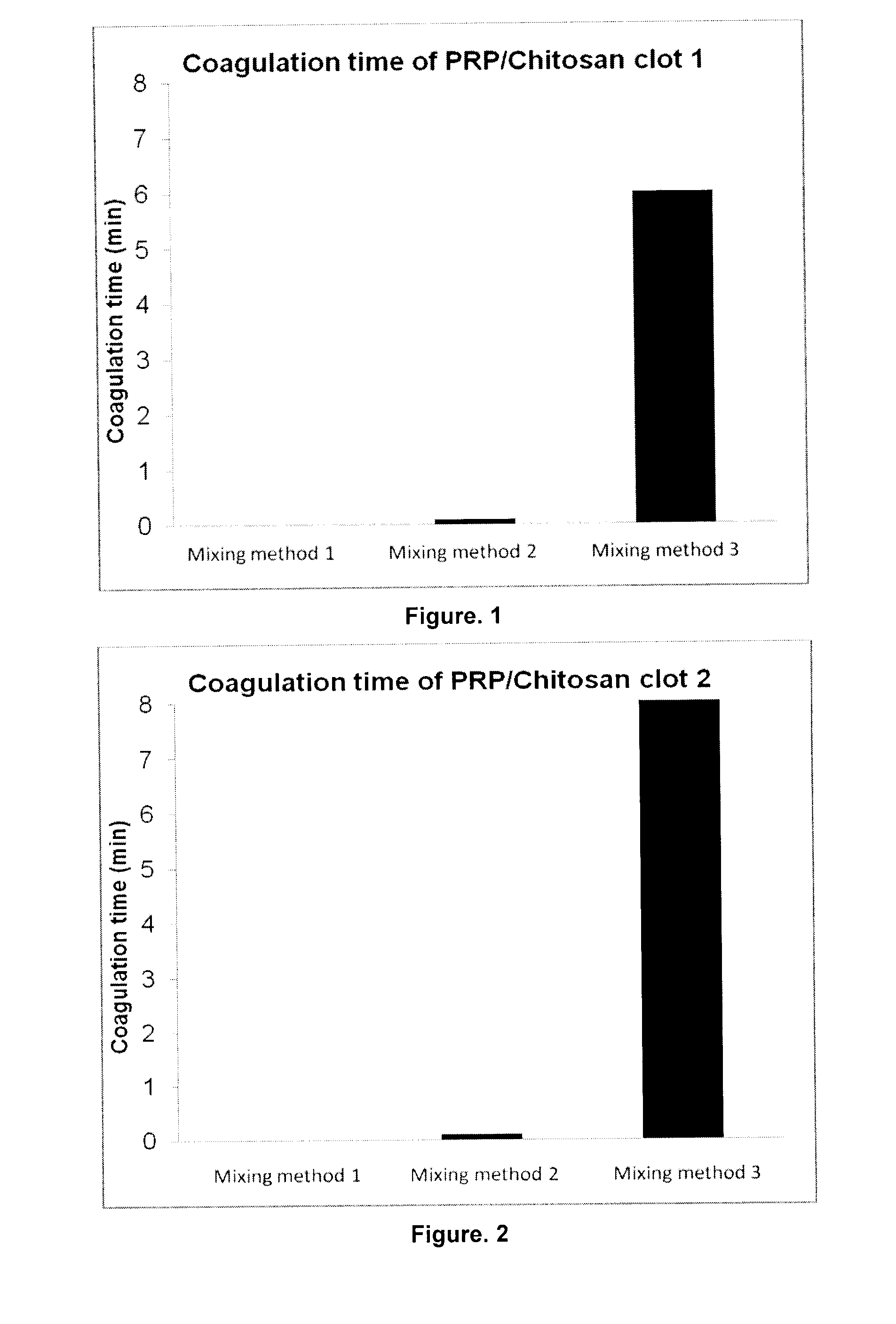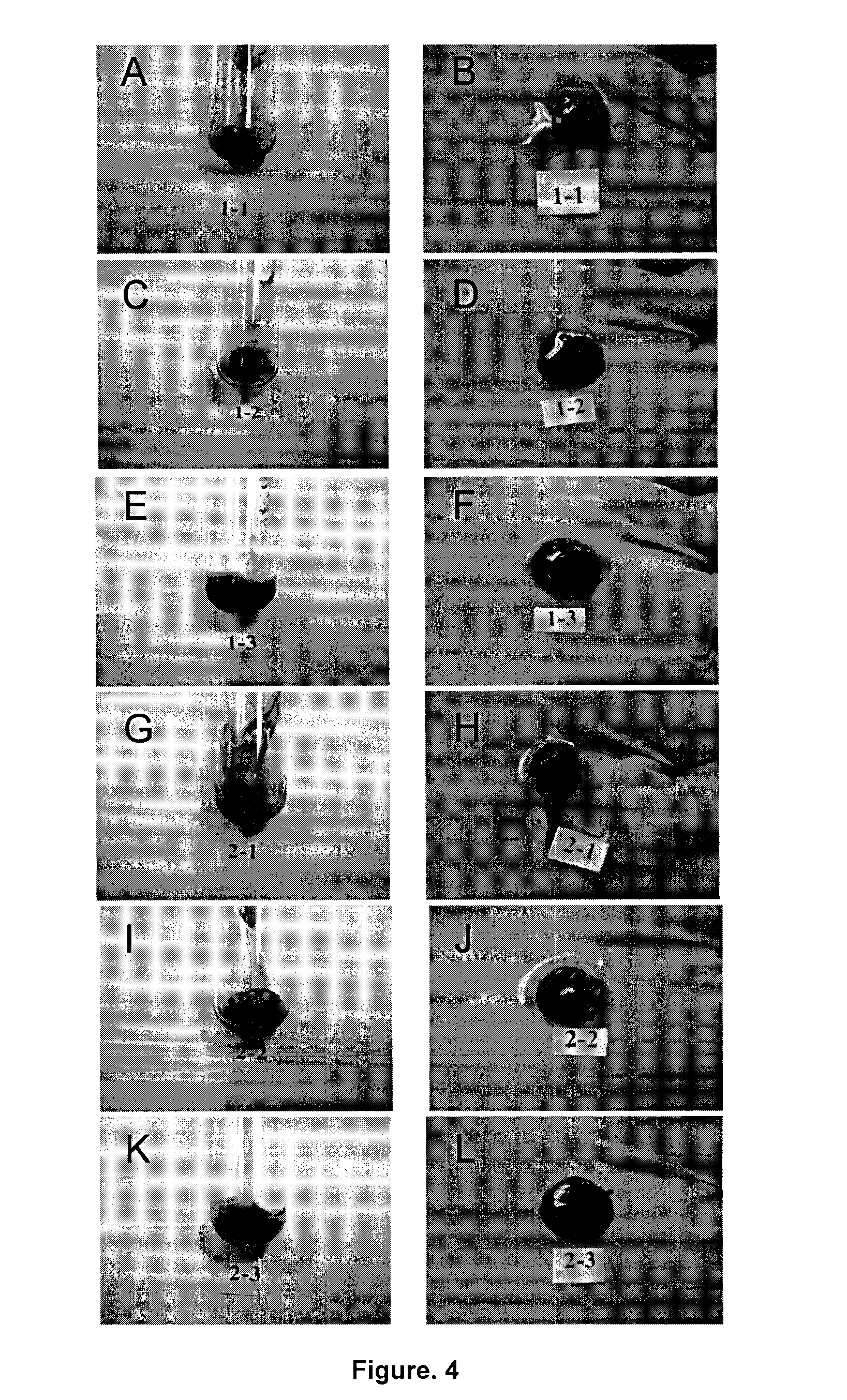Soluble physiological chitosan formulations combined with platelet-rich plasma (PRP) for tissue repair
a technology of physiological chitosan and platelet-rich plasma, which is applied in the field of soluble physiological chitosan formulations combined with platelet-rich plasma (prp) for tissue repair, can solve problems such as problems such as problems such as problems such as its use in solution with living cells and tissues, and achieve the effect of promoting cell proliferation
- Summary
- Abstract
- Description
- Claims
- Application Information
AI Technical Summary
Benefits of technology
Problems solved by technology
Method used
Image
Examples
example 1
Formulation and Characterization of PRP / Chitosan Clots Activated by Thrombin and Prepared with Different Mixing Methods (Human Blood)
[0079]1—Preparation of Chitosan (1.62% w / w)-HCl (38 mM)-NaCl (160 mM) Solution; without NaOH, pH: 6.6; Total Volume: 10.0 ml
[0080]0.180 g of chitosan (Mn 232 kDa, 81% DDA) was weighed in a 20 ml beaker, H2Odd was added to the beaker, until the weight of chitosan+H2O=9.34 g. A magnetic stir bar was inserted into the beaker; the solution stirred for about 10 minutes in order to hydrate the chitosan powder as much as possible. 0.38 ml of HCl 1 N (Sigma, Product No. 318949) was added to the solution under moderate stirring. The beaker was covered with Parafilm™, and the solution heated to about 60° C. for 2 hours, stirred overnight until completely dissolved. 0.32 ml of 5N NaCl (Sigma, Product No S-9888) solution was added into the beaker and well mixed. The pH of the chitosan solution was physiological at 6.5 and the osmolality was also physiological 361 ...
example 2
Runniness Test and Coagulation Time Test for PRP / Chitosan Mixtures without any Activators (No Thrombin or Calcium) by Using Different Mix Ratios
[0096]1—Preparation of Chitosan (1.62% w / w)-HCl (38 mM)-NaCl (160 mM) Solution; without NaOH, pH: 6.6; Total Volume: 10.0 ml
[0097]The chitosan-HCl—NaCl solution was prepared with chitosan Mn 232 kDa, 81% DDA as described hereinabove. The pH of the chitosan solution was physiological at 6.6 and the osmolality was also physiological (359 mOsm / kg; Table 5).
2—Preparation of Chitosan (1.62% w / w)-HCl (71 mM)-βGP (2.15%) Solution, pH: 6.6, Total Volume: 9.0 ml
[0098]The chitosan-HCl-βGP solution was prepared with chitosan Mn 232 kDa, 81% DDA as described hereinabove. The pH of the chitosan solution was physiological at 6.6 and the osmolality was also physiological (352 mOsm / kg; Table 5).
TABLE 5Composition and properties of chitosan solutions.Solution No andCchitosanCHClCNaClCβGPpHOsmolalitytype.(% w / w)(mM)(mM)(% w / w)Precipitation(Measured)(mOsm / kg)1...
example 3
Preparation of PRP / chitosan Clots by using 1.62% and 2.0% Chitosan Solutions at Mix Ratios of 2:1 and 3:1 and with a Small Volume of CaCl2 Solution as Activator
[0109]1—Preparation of Chitosan (1.62% w / w)-HCl (38 mM)-NaCl (160 mM) Solution; without NaOH, pH: 6.6; Total Volume: 10.0 ml
[0110]The chitosan-HCl—NaCl solution was prepared with chitosan Mn 232 kDa, 81% DDA as described hereinabove. The pH of the chitosan solution was physiological at 6.6 and the osmolality was also physiological (344 mOsm / kg; Table 9).
2—Preparation of Chitosan (2.0% w / w)-HCl (50 mM)-NaCl (150 mM) Solution; pH: 6.5; Total Volume: 10.0 ml
[0111]0.222 g of chitosan (Mn 232 kDa, 81% DDA) was weighed in a 20 ml beaker, H2Odd added to the beaker, until the weight of chitosan+H2O=9.20 g. A magnetic stir bar was inserted into the beaker; the solution stirred for about 10 minutes in order to hydrate the chitosan powder as much as possible. 0.50 ml of HCl 1 N (Sigma, Product No 318949) was added to the solution under ...
PUM
| Property | Measurement | Unit |
|---|---|---|
| osmolality | aaaaa | aaaaa |
| osmolality | aaaaa | aaaaa |
| osmolality | aaaaa | aaaaa |
Abstract
Description
Claims
Application Information
 Login to View More
Login to View More - R&D
- Intellectual Property
- Life Sciences
- Materials
- Tech Scout
- Unparalleled Data Quality
- Higher Quality Content
- 60% Fewer Hallucinations
Browse by: Latest US Patents, China's latest patents, Technical Efficacy Thesaurus, Application Domain, Technology Topic, Popular Technical Reports.
© 2025 PatSnap. All rights reserved.Legal|Privacy policy|Modern Slavery Act Transparency Statement|Sitemap|About US| Contact US: help@patsnap.com



